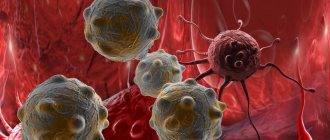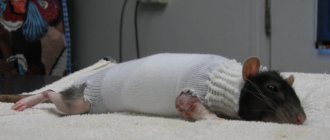Are you suffering from abdominal pain, cramps and constant bowel movements? Unpleasant sensations in the intestinal area can ruin all plans, so we use various medications to relieve abdominal discomfort. But these measures only allow you to temporarily get rid of the symptoms of a serious disease, which return again and again. What if these symptoms have a single cause - irritable bowel syndrome? What this disease is, what its symptoms are and how to cure it, we will tell you in this article.
What to do if your hamster is constipated
Every day the charming hamster cheers up its owner and goes into his arms.
Suddenly, the affectionate rodent becomes extremely restless and its abdomen swells. What should an owner do if a hamster is constipated? It is necessary to help the animal cleanse its intestines; constipation can cause poisoning of the body, the formation of coprostasis, rectal prolapse from the anus and death. It is usually the owner's fault that a hamster does not poop. If a rodent does not have access to drinking water and eats a lot of dry food, then it gradually develops constipation. Fiber is a biological causative agent of peristalsis; it is found in buckwheat, couscous, oatmeal, corn, fruits and vegetables. An unbalanced diet is the main cause of this unpleasant disease. Sometimes a hamster does not have bowel movements due to anxiety, various diseases of the small and large intestines, and mechanical damage.
Why does bloating occur?
Bloating and flatulence can be caused by various reasons. But in any case, these are symptoms indicating possible problems with the digestive system. Increased gas formation is accompanied by the vast majority of diseases of the gastrointestinal tract (GIT). One of the causes of bloating may be aerophagia - swallowing air while eating. This can happen due to conversations during feasts, during quick snacks on the go and due to factors such as smoking, poor-quality jaw prostheses, etc.
Another common cause of discomfort after eating, leading to bloating, is the consumption of foods that increase gas formation and poorly tolerated foods, such as milk2.
Even in completely healthy people, flatulence can occur when consuming the following foods:
- legumes: peas, beans, lentils;
- vegetables: cauliflower, Brussels sprouts, white cabbage, broccoli, radishes, celery;
- some grains: bran, wheat germ, corn;
- baked goods: pies, buns, bagels;
- sweets: cookies, cakes, pastries, ice cream;
- flour: bread, dumplings, pasta;
- dairy products, especially fresh milk;
- fruits with a high fructose content: grapes, figs, melon, pear, dates;
- carbonated drinks and fruit juice concentrates;
- containing cocoa: coffee, chocolate.
The appearance of bloating can be caused by impaired digestion of carbohydrates entering the body with food. The reason for this may be a lack of digestive enzymes. If the body does not have enough digestive enzymes, their deficiency must be compensated. For this purpose, there are preparations that contain the required amount of enzymes similar to those produced by the body3. Such drugs include Creon®. The drug is available in the form of capsules that contain hundreds of small particles - minimicrospheres. Today, this is the most effective form of release of pancreatin, the active ingredient of enzyme preparations4. It is important to note that Creon® minimicrospheres are produced using patented technology and therefore other drugs cannot replicate it. Why are small particles needed? Enzyme preparations are designed to improve digestion, that is, break down and digest food. To perform this task, the drug must be evenly mixed with food. Only in this way will he be able to capture and help “process” the maximum amount of food eaten. If the drug does not have small particles, then it will only partially affect food.
Causes of constipation in a hamster
Typically, intestinal dysfunction in hamsters develops due to the fault of the owners. The reason is insufficient intake of moisture and fiber. Thus, constipation is primarily caused by excessive consumption of dry food and insufficient drinking water. Fiber starts the digestion process. It is found in vegetables, fruits and grains. The lack of such food in the animal’s menu is the root cause of the development of the disease. Less common factors are stress, trauma and intestinal pathologies.
What is irritable bowel syndrome?
This is a disorder of the intestines and discomfort in the abdomen during bowel movements. The syndrome itself is not a disease, but rather a set of symptoms that often occur for an unknown reason. Unfortunately, such a disorder can significantly reduce a person’s quality of life, forcing him to remain in an uncomfortable state: digestion is disrupted, metabolic processes in the body worsen, and the saturation of the human body with nutrients decreases.
Irritable bowel syndrome is a very common occurrence among people aged 25 to 40 years. Statistics show that at least once in their life, every third person has experienced the unpleasant symptoms of irritable bowel syndrome.
Self-medication in this case can be very dangerous to health. The fact is that the syndrome is treated comprehensively and under the close attention of the attending physician. The consequence of self-medication can be intestinal obstruction and numerous chronic gastrointestinal diseases. With the first signs of irritable bowel syndrome, you should contact a therapist, who will refer you to a more specialized specialist - a gastroenterologist. The diagnosis is usually made only after excluding tumors and inflammatory changes in the intestines.
The intestines are where food is digested and nutrients are obtained by the body. When food enters the intestines, it moves along the intestines. This process of advancement is achieved through the work of smooth muscle cells within the intestinal walls. The cells alternately contract and relax. But when IBS (irritable bowel syndrome) appears, cell function is disrupted. Food begins to pass through the intestines either too quickly or too slowly. The result is discomfort and constipation or diarrhea.
Treating constipation in a hamster at home
What to do if it becomes clear that your hamster is constipated? First of all, it is necessary to provide it with water and a small amount of succulent food, vegetables and fruits. It is better not to give hamsters laxatives. Instead, the animal is given 1–2 ml of Vaseline oil from a syringe. You need to carry out two such procedures with a difference of 20 minutes, then wait 4 hours. If the intestines have not emptied, the hamster continues to be fed with oil.
To alleviate the condition, you can inject a little vegetable oil or a mixture of baxopan with paraffin oil into the anus. This must be done very carefully so as not to damage the thin mucous membrane. Therefore, it is better to have this procedure performed by a veterinarian. After this, it would be useful to massage your pet’s tummy clockwise, and then make him move, run, and play. This activates the digestive processes.
Signs of involuntary muscle contraction are:
- with bruxism – grinding of teeth during sleep, a feeling of overexertion in the jaws after waking up;
- with spasms of the head muscles - hoop-shaped pain in the temples, in the forehead, in the back of the head;
- pressing, pulsating, squeezing nature of pain;
- feeling of heaviness in the area of spasm;
- pain when pressing trigger points (try to palpate the area of the head when it hurts: when you press certain points, the pain increases significantly);
- nausea, vomiting, dizziness;
- painful reaction to light, loud sounds (infrequently).
When to see a doctor:
- headaches appeared suddenly and do not go away;
- you are experiencing muscle pain for the first time after 50 years;
- pain is accompanied by dizziness, weakness, numbness of the limbs;
- pain lasts more than two weeks in a row;
- painkillers either do not work at all or give an insignificant short-term effect;
- the pain is localized on one side of the head/neck.
Muscle spasms that provoke pain indicate a disruption in the healthy functioning of the body. To prevent the development of the disease, it is important to consult a doctor in time. We advise you to visit a therapist, neurologist, endocrinologist, who will prescribe detailed laboratory diagnostics for you. Based on the research results, specialists of another profile may be involved in your treatment: an orthopedist, a cardiologist, a chiropractor. Complex treatment may include taking medications, a massage course, and therapeutic exercises. A good doctor will definitely give you recommendations on nutrition and daily routine.
MIGUNOVA ANASTASIA ANDREEVNA
Cosmetologist
Initial consultation: RUB 4,500
Make an appointment with a doctor Instagram
VYATKINA IRINA SERGEEVNA
Gynecologist-endocrinologist
Initial consultation: RUB 8,500
Make an appointment with a doctor Instagram
KALININA EKATERINA ALEXANDROVNA
Cosmetologist
Initial consultation: RUB 4,500
Make an appointment with a doctor Instagram
KOZLOVA EKATERINA NIKOLAEVNA
Gynecologist-endocrinologist, oncologist
Initial consultation: RUB 5,000
Make an appointment with a doctor Instagram
Treatment of constipation in a hamster in a veterinary clinic
If your hamster's stool does not return to normal within 24 hours after starting treatment, you need to go to the veterinarian. The doctor performs an ultrasound and prescribes treatment. To cleanse the animal's intestines, he gives an enema using painkillers. In case of intoxication and dehydration, the doctor injects the hamster subcutaneously with Ringer-Locke solution. To normalize the intestinal microflora, the veterinarian recommends a special probiotic. After a few days of examination, the hamster should recover. But if intestinal obstruction occurs, surgical intervention and rehabilitation are necessary.
After treatment, the animal is fed for some time with semi-liquid plant food: boiled buckwheat, carrots, prunes, oat leaves, parsley, dill. You can add some sunflower seeds. Dairy products, meat, eggs, flour products and dry food should not be given.
Diagnosis of irritable bowel syndrome
If you have all the symptoms of the disease listed above, consult a physician. He will conduct an initial examination and refer you to a gastroenterologist. The purpose of primary diagnosis is to exclude the presence of other life-threatening diseases: tumors, inflammatory processes, growths, infectious diseases.
When visiting a doctor, you need to provide a complete medical history, report the presence and frequency of symptoms, and talk about the presence of chronic diseases. After examination and palpation (feeling), the specialist will refer you for laboratory tests, including:
- General blood analysis. The analysis allows you to determine whether an inflammatory process is present in the body, as well as to determine possible anemia.
- General urine analysis. Determines the presence or absence of blood and parasites in the patient’s body, which allows us to talk about the development of a number of intestinal diseases other than irritable bowel syndrome.
- Blood test for celiac disease. A specific blood test that allows you to identify a disease of the digestive system (celiac disease), in which the intestines cease to properly digest incoming food, which is accompanied by diarrhea.
- Colonoscopy. This is an examination of the colon from the inside using a special device (colonoscope).
- Magnetic resonance imaging of the pelvis and abdomen. This is a non-invasive examination method that allows you to study the structure and condition of the organs and tissue of the pelvis in men and women using magnetic waves.
After all the studies have been carried out and all other intestinal diseases have been excluded, the doctor begins treatment and prescribes complex therapy, based on the patient’s medical history.
Hamster diseases: their symptoms and treatment
Any pet can get sick, hamsters are no exception. In order for the animal to feel better and the disease not to progress, it is important to know the methods of treatment and the main signs of illnesses in animals. Diseases of hamsters, the symptoms and treatment of which will be obvious to the veterinarian, are not always visible to the naked eye to household members. Often, owners are not even aware of the animal’s health problems, which leads to disastrous consequences. There is a whole list of problems that can happen to these creatures.
Symptoms
In a hamster's condition, it is difficult to notice symptoms until they become obvious. In the early stages, diseases can most often be cured, but as they progress, this becomes more difficult. To detect small signs, you should examine your pet daily and look closely for any behavioral changes. Diseases of hamsters, the symptoms and treatment of which are largely similar, can be identified by the following signs:
- activity: if the animal has become lethargic, an illness may be present;
- Appetite: A healthy hamster loves to eat. If he refuses to eat even for a day, the problem is serious and urgent measures need to be taken;
- weight: the Syrian weighs about 90 g, and the Djungarian hamster does not weigh more than 30 g in a healthy state;
- muzzle: in a healthy state, the eyes should shine and there should be no mucus; the nose is always cool, there is no discharge; ears do not peel; the fangs are even, do not interfere with the hamster closing his mouth;
- tumors: there should not be even minimal growths anywhere on the body;
- butt: hamsters are clean animals. This part of the body in healthy individuals is always clean and dry;
- discharge: feces should not have a pungent odor (like urine), the consistency should be solid. The color of the waste is predominantly gray.
Prevention
To keep your hamster always healthy, preventive measures should be followed. Nutrition should be complete, there are enough vitamins. Change the hay in the cage as often as possible so that it does not become stale. Drinking water must be clean and fresh. Once a week, ascorbic acid is added to the liquid to prevent a number of diseases. Sometimes include milk in your diet; it is rich in vitamins.
It is important to protect your pet from contact with wild rodents to prevent the infection from being transmitted. There should be no draft in the cage (this can lead to ear diseases, colds and conjunctivitis), or lack of light. The cage and contents should be disinfected every couple of weeks.
If a disease is suspected, the first step is to isolate sick hamsters. A veterinarian will make the correct diagnosis; the disease may not manifest itself for a long time, and the hamster will only experience mild discomfort. The sooner you go to a professional, the greater the chances of recovery.











